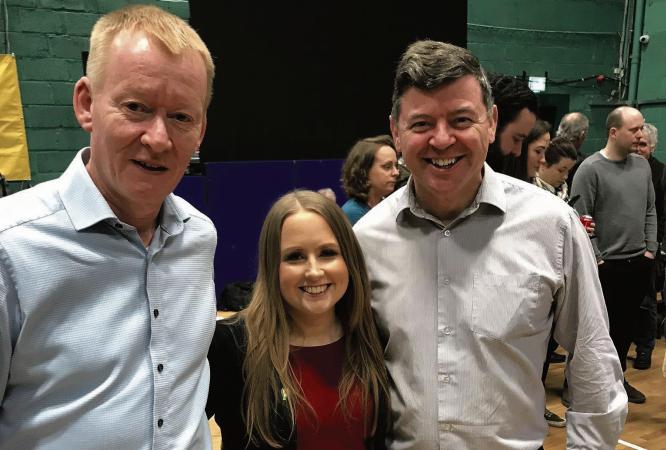Political World
Myth-busting about parties, independents and whips

It’s amazing the myths that still persist about politics.
For one, the notion that Irish politics is still dominated by the big two parties, Fianna Fáil and Fine Gael, and therefore they need to somehow coalesce if we are to get anywhere.
It’s nearly 40 years now since we have had a majority single party government. Every administration since then has either been a minority or a coalition.
Indeed, given our electoral system, coalitions are now a way of life.
By the ’70s, the political attachments forged out of the civil war were on the wane. Sure, there are always families for whom fealty to a political party will be in their DNA. The respective positions of party on the “national question” will also be a factor for some.
But for most born from the 1960s onwards, there were two over-riding factors. The first was that party loyalty was not set in stone. The second was that votes were cast pragmatically in favour the party that was considered the best to govern the country.
Fianna Fáil and Fine Gael have both been in long-term decline.
For Fianna Fáil, its status as the natural party of government masked that decline during the good years, when floating voters continued to back it. When the fall came, it hurled the party down to the floor. It will come back, but below the support levels it would have expected.
Fine Gael will manage to keep its head above the water and will, in the short-term, stay ahead of its traditional rival in the battle to be the biggest.
Ironically, for both parties to remain strong, they need the other to be strong, but not as strong as it is. It’s a bit like Gaelic Games having vintage years when the two traditional powerhouses, Kerry and Dublin, are strong.
Another myth revolves around Independents. A whole narrative has grown up over the past couple of years that more or less claims that they have come from nowhere and are now a real force in Irish politics.
In the first instance, a lot of this is based on opinion polls – and mid-season ones at that. They tell you not very much. And what they do tell you, they say it in the crudest way.
For example, there will always be blowback for governments in the mid-term. They have either introduced unpopular measures or have raised taxes or charges.
Polls (as well as by-elections and second-tier elections such as locals) give the electorate the chance to exercise their displeasure.
People tend to think more intensely about casting their vote when it comes to a General Election. There are loads of reasons why somebody would support a political party (somebody would feel very strongly about the Irish language or climate change or social policies, for example).
But for most people they want a back a Captain who is not going to steer the ship of State onto the rocks, who will ensure they can get jobs, keep their jobs, get services, not pay over onerous taxes. Some will be lured by big promises – most will be wise to empty ones.
For more of Harry McGee’s myth-busting see this week’s Tribune.
Connacht Tribune
The fine art of good timing when it comes to elections

World of Politics with Harry McGee
Academically, politics is described as a science. But in the real world, it’s more of an art – and one of the big decisions a Government has to make is to decide when to call an election.
Will they see out the full term, or will they go early – either to mitigate the damage they will ship, or to secure a victory before things go awry, or the economy takes a dip, or some kind of controversy erupts?
Timing is everything.
And there’s a bit of art to that – not to mention a lot of luck. If you call it early and win big, you’re a genius. If you call it early and lose, you are the political version of the village fool.
Charlie Haughey was a poor judge of the public mood. Twice he called snap elections and on both occasions they backfired. Haughey succeeded Jack Lynch as Taoiseach in late 1979 and did not – technically – have his own mandate. He tried to remedy that by calling an election in 1981. But it recoiled. Ray MacSharry warned him not to hold it during the H Block hunger strikes when republican prisoners were dying each day. He did not listen to the advice and found himself out of office.
After his return to power in 1987, Haughey tired of presiding over a minority government that kept on losing votes in the Oireachtas (the opposition won nine private members motions).
So he called a snap general election and it backfired. Fianna Fáil lost seats and had to broker a coalition deal with the Progressive Democrats and his long-standing political adversary Dessie O’Malley.
For more, read this week’s Connacht Tribune.
Connacht Tribune Digital Edition App
Download the Connacht Tribune Digital Edition App to access to Galway’s best-selling newspaper.
Click HERE to download it for iPhone and iPad from Apple’s App Store, or HERE to get the Android Version from Google Play.
Or purchase the Digital Edition for PC, Mac or Laptop from Pagesuite HERE.
Get the Connacht Tribune Live app
The Connacht Tribune Live app is the home of everything that is happening in Galway City and county. It’s completely FREE and features all the latest news, sport and information on what’s on in your area. Click HERE to download it for iPhone and iPad from Apple’s App Store, or HERE to get the Android Version from Google Play.
Connacht Tribune
Inch protest arguments are more subtle than Oughterard

World of Politics with Harry McGee
I was cycling down Mount Street in Dublin on Tuesday. It’s a wide esplanade that links the Grand Canal with Merrion Square. The street is a mixture of fine Georgian buildings and modern office blocks.
About half-way down is the office of the International Protection Office, which deals with asylum seekers who have arrived in the country.
Needless to say, the office has been overwhelmed in the past year. Besides an estimated 80,000 refugees who have arrived from Ukraine, there have been about 20,000 people from other parts of the world who have arrived into Dublin (mostly) claiming asylum.
The numbers peaked around Christmas, but they have been falling a little. In January, more than 1,300 people arrived seeking asylum but the numbers fell back to 831 and 858, in February and March respectively.
They are still huge numbers in a historical context.
So back to my cycle on Tuesday. I knew that some asylum seekers were camping outside the International Protection Office, but I was taken aback by how many. There were six tents lined up on the pavement directly outside. Then on the ramp that led down to the basement carpark on the side of the building, there were about another 20 tents.
It looked like what it was, a refugee camp in the middle of Dublin’s business district. If you pan out from Mount Street, you will find tents here and there in nearby streets and alleys. There were a good few tents in an alleyway off Sandwith Street about 500 metres away.
For more, read this week’s Connacht Tribune.
Connacht Tribune Digital Edition App
Download the Connacht Tribune Digital Edition App to access to Galway’s best-selling newspaper.
Click HERE to download it for iPhone and iPad from Apple’s App Store, or HERE to get the Android Version from Google Play.
Or purchase the Digital Edition for PC, Mac or Laptop from Pagesuite HERE.
Get the Connacht Tribune Live app
The Connacht Tribune Live app is the home of everything that is happening in Galway City and county. It’s completely FREE and features all the latest news, sport and information on what’s on in your area. Click HERE to download it for iPhone and iPad from Apple’s App Store, or HERE to get the Android Version from Google Play.
Connacht Tribune
Sinn Féin hunt for seats in ‘locals’ across Galway

World of Politics with Harry McGee
God that was a dramatic and historic weekend in England, wasn’t it? So much excitement, so much change, so much hype, so much out with the old and in with the new, and what looks like the coronation of a new leader. Yes, the local elections in Britain were something else weren’t they!
Apologies for not going on about King Charles III but the contract I signed when I became a lifelong republican forbids me to discuss the topic!
I know the British local elections sound a bit boring by comparison, but the results were stunning.
The Conservatives lost nearly 1,000 seats, the British Labour Party gained almost 500 and both the Lib Dems (with 350 gains) and the Greens (gaining over 200) also had amazing days at the polls.
It was Labour’s best day since 2002 but its victory was only partial. The Greens and the Lib Dems actually made gains at the expense of Labour in more affluent areas, and in parts of Britain where there were high numbers of graduates.
It was in the Red Wall constituencies in the North of England where the Labour recovery was strongest. These are working class constituencies with pockets of deprivation where people voted for the Labour Party forever. But all of those constituencies voted for Brexit and then voted for the Tories in the next general election. Labour is now winning back some of those votes.
Local elections are classified as second-tier elections which essentially means – from a national perspective – they are not life-or-death affairs, and not everything turns on them. Of course, it’s really important to have good local representation. But they are not an amazing weather vane for who rules the country.
For more, read this week’s Connacht Tribune.
Connacht Tribune Digital Edition App
Download the Connacht Tribune Digital Edition App to access to Galway’s best-selling newspaper.
Click HERE to download it for iPhone and iPad from Apple’s App Store, or HERE to get the Android Version from Google Play.
Or purchase the Digital Edition for PC, Mac or Laptop from Pagesuite HERE.
Get the Connacht Tribune Live app
The Connacht Tribune Live app is the home of everything that is happening in Galway City and county. It’s completely FREE and features all the latest news, sport and information on what’s on in your area. Click HERE to download it for iPhone and iPad from Apple’s App Store, or HERE to get the Android Version from Google Play.















